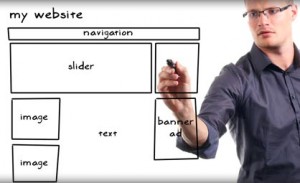
Noting when your site is outdated can sometimes be the easiest part of the website maintenance – see this post How Updating a Website Is Essential to Your Business for a few ideas. Implementing changes become the challenge, which sometimes mean a major upgrade or redesigned site.
If you find your business facing a site update, here are some starter ideas to approach the layout, and have a smoother discussion with a designer or developer.
- Layout a wireframe of the site appearance – focus on what pages should be in the site. Plan how they will appear in the navigation, as well as whether or not subdirectories and pages on other sites are used. A wireframe can be drawn on piece of paper, as well as created in online software as Omnigraffle.
- Decide the content associated with each page. Plan for short content and how images can be arranged. The arrangement can reveal how you expect a visitor to review the site. You can then plan how an analytics tag should be implemented.
- Decide on a keyword strategy based on the content presented. Plan for non-branded keyword terms (for discovery of your business) and branded terms (to strengthen a brand) - words that contain your business name, or persons involved in a website who are well known online.
- Create a relatively broad list keywords for search engine optimization, though remember to select words that speak to your customers. Spend time crafting the text around the selected keywords to explain the benefit customers receive from working with your business.
- Insert keywords in your image filenames when applicable. The file names can appear in the HTML code for a page on which the image appears. To be manageable and not overwhelmed by managing pictures, keep images to a low count 30 if possible and avoid stock photos – Thanks to Pinterest and Facebook, customers are expecting real experiences when they come to see you.
- Avoid animations or flashy splash pages on a page. Page speed has increasingly become a factor in visitor enjoyment of a site, as well as a factor in search engine consideration. Moreover many people view websites through a smartphone, even ones not optimized for mobile, so adding extra flash to entertain viewers is outdated.
- Consider how images are arranged on each page - as parallax or as a carousel. This will cut the size requirements of a page, as well as provide another way for customers to remain engaged. Let the designer know if you plan to update pictures more than once, so that they can review with you where new images can be placed in the site code.
- When adding a mobile site, choose simple actions a visitor would take to contact your business online. An example is being able to call your business via a simple button instead of forcing a dial up of a number.
- Footer content should appear across each page, containing social media buttons (Twitter, Pinterest, Facebook, Google Plus, Reddit, etc). It should contain the business address, as well as links, badges, and widgets for other associations, such as the Better Business Bureau or trade association membership. Because social media platforms and organization typically considered highly ranked in a search engine, placing these into the footer can strengthen search engine optimization.
- Gather customer accolades for a display on the site. They can appear on main page, one or two on every page, or in a dedicated page for “what customers are saying about us.”
- Analytics tag should be decided such that future digital marketing efforts can be planned. Plan exactly what marketing tools will be used, so you have an idea of what to add.
- Do not seek to build a great amount of traffic initially. Overcapacity can slow down loading times, hindering customer service, and make the site appear mismanaged by visitors. Build traffic over time, monitoring performance to make adjustments that will come for every site. Make sure a set aside budget for upgrades and site improvements.
When you have established your choice for a website design, avoid delays to deliver your content. Adding more than a few months to code and finalize function because of a last minute request can be problematic for your designer and ultimately your business.
Only use content and media essential to convey your service, product or organization. Revising media and content continually without a dedicated staff or schedule creates a diversion from other essential business tasks and adds unnecessary costs to your business.
To manage the changes you want to see, develop a timeline and manage it with a project manager. Basecamp has a great project manager, popular because of the number of plugins that sync easily and can saving time in integrating information.
[…] Ideas To Plan Your Small Business Website […]
Quality posts is the most important aspect in attracting viewers to visit the website.
Certainly agree, Mattie! Thanks for your comment!
^PDeB
Shades are an essential component of web design and
unless individuals start liking black-and-white, this will certainly
not go out of season.